Ready for the rush?
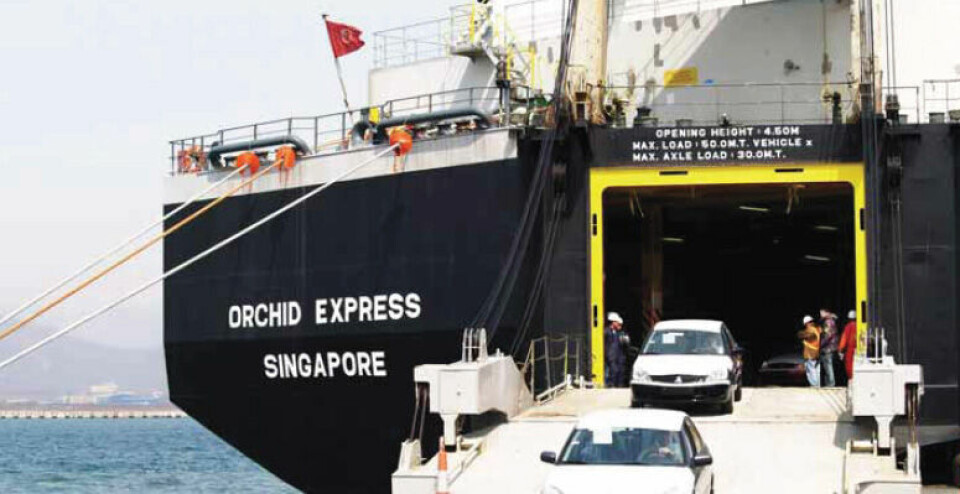
Chris Lewis takes another look at the finished vehicle imports going though ports into Russia, and discovers that business is seriously picking up, and that homegrown ports are ready to handle returning volume.
When Russia started to open up to the international car market, its port infrastructure was patently unable to cope, as multiple headlines reported on the pages of this magazine in the heady days before the financial crash. Having never been among the world’s greatest trading nations, Russia and later the Soviet Union had long lacked adequate infrastructure, while ‘modern’ concepts like ro-ro and containers had made only limited impact. Mother Russia supplied most of her citizens’ fairly limited needs from within her own borders.
From the 1990s, most cars were imported via Finland and, to a lesser extent, other Baltic, Scandinavian and continental European ports, which had modern facilities, flexible customs and duty regimes and better security.
But in the painful boom-bust recovery arc that Russia has followed recently, there has been a further major change. According to Svein Steimler at NYK Group Europe, recent years have seen significant development in Russia’s ports. “There has been noticeable development even in the last few months between June and October [2010],” he says. The new port of Ust-Luga has come on stream, replete with a car terminal, and terminals in St Petersburg, the historical gateway to western Russia, have been improved. Steimler says that he is “impressed by the speed of development”, not just in the ports but on the road system too.
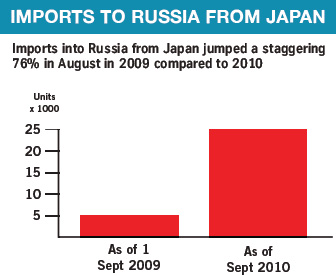
It’s time to ship direct
Many of these port improvements came just as the Russian car market went into a deep recession, but now that business is returning, car importers are finding that there is often enough capacity to ship cars direct into the country.
It is still unknown whether the Russian ports could cope with the bulk of the trade should business return to something like the boom years earlier in the decade, though Svein Steimler suspects that they will. “If we were to use a hub for Russia, it would probably be somewhere outside the region altogether like Zeebrugge, so we will effectively be going direct into the country for most volumes.”
UECC, says Bjorn Svenningsen, serves ports in Finland and Russia, including Ust-Luga and St Petersburg. However, duty reforms in Russia will probably shift a large proportion of the trade to Russian ports. “I think the pattern of trade will change quite a bit, and, while there is still some demand for Finland, more of the OEMs will switch to Russian ports,” he says. He observes that traffic into Russia is brisk again. While volumes are far off the peaks hit earlier in the decade, business is currently up by about 50% year on year.
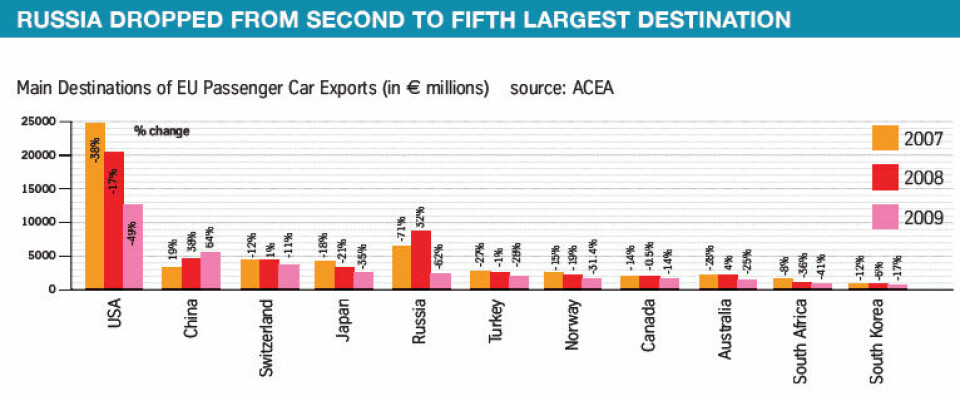
This time, Russia’s ports are handling the increased volumes without the congestion seen a few years ago. Facilities have been modernised and although fragmented, operations in St Petersburg are on the whole running smoothly. One problem for the shipping lines and the industry is that vessels frequently have to switch between terminals in St Petersburg.
In the long term, though, an expanded Ust-Luga and also the planned new port slightly to the north at Nova Gavan should provide capacity. Another ro-ro entry point in St Petersburg is Petrolesport port (PLP), operated by the Rolf Group. However, as a city-centre port, its capacity is restricted. Nevertheless it will probably be quite a while before Ust-Luga and its inland transport links are able to handle significant volumes of traffic, believes Rolf ’s Stephen Fletcher.

Finland will lose out
Ust-Luga Company’s Alexander Goloviznin says that when Russia started to import cars on a large scale, the Finns were at that time in a better position to fulfil the need. “In those days importers of cars into Russia were independent and OEMs were not ready to ship cars to Russian ports if vehicles were not pre-paid. But who could afford such a cash flow gap?” Today, since the majority of importers are OEM subsidiaries, there is less of an issue around the inventory investment, and thus more cars can be shipped directly to Russia.
Ust-Luga is arguably the most modern port in Russia; its car terminal is set to have a 11,500 unit storage capacity by the end of 2010. Key existing clients include Toyota and Glovis. There has thus been a transformation in the pattern of Russia’s automotive trade, says Goloviznin. “Some OEMs are still using Finnish ports, but the majority have changed to Russian terminals. It is in fact easier to say ‘what is left?’ in Finland–Suzuki, Honda, Mitsubishi, JLR, Volvo and, in winter only, Mazda.”
He adds that if there were to be an upsurge in the Russian car import market to 2008 levels, the country’s ports would now be well placed to handle it, as the industry is in a better position to properly plan its logistics than during the ‘gold rush’ years earlier in the decade. Some of the more bullish OEMs are indeed talking about a return to 2008 traffic levels, though that might be over-optimistic, he believes. Ust-Luga is planning to handle about 64,000 vehicles in 2010 and discharged 10,885 in September alone. In 2011, with more regular service calling the port, it expects to handle at least 160,000 cars.
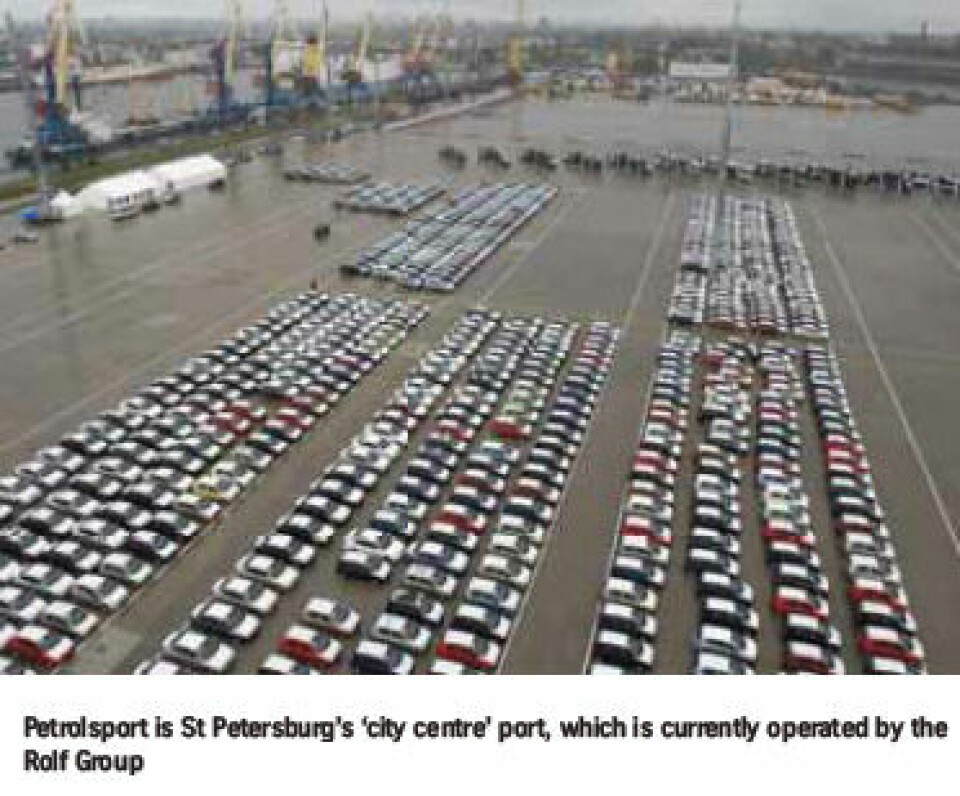
Toyota supports revised customs rules
Toyota has reconfigured its supply chain in favour of Russian ports, explains Cyran Vanderhaeghen. “Next year, we plan to target all our Russian [imports to] St Petersburg and Ust- Luga,” he says. “We believe that the overall efficiency will be higher in terms of lead time and the cost of the total supply chain from the factory to the retailer will be lower.” The clincher for Toyota is that the customs service has agreed to allow duty-free storage in Russian ports for up to 120 days (60 days automatically, extendible by arrangement.) Russian customs rules remain opaque, but Vanderhaeghen is reasonably confident that the new arrangements will work well; as Vanderhaeghen further points out, a lot of the recent investment in Russian ports has been made on the assumption that a revised customs regime will attract new business. Security is less of a worry in Russia, particularly for massmarket cars. Toyota has been operating without problems in Ust-Luga since 2009, and the port now handles around half of its Russian volumes. The rest currently goes via Hanko, but in 2010 almost all traffic will move to Ust-Luga or an as yet unnamed terminal in St Petersburg. Hanko will then handle only Finnish traffic and specialist vehicles for Russia. Traffic will be moved from the ports to retailers by road, although Toyota might consider using rail in the longer term. There is however a shortage of suitable wagons and the rail tariffs are not conducive to “short”-distance movements of around 800km–that is, short for Russia.
Toyota may also consider using inland hub terminals, particularly to serve the smaller markets in eastern Russia. However, as the regulations currently stand, cars could not be stored duty and VAT free here as they could in the seaport. However, an inland hub might work for a cross-dock type operations where dwell times were short.
Making better use of space
Three years ago, getting space in St Petersburg used to be difficult, if not impossible, but things are changing, says Uwe Seliger at BLG. “We have a strategic partnership with the port for 100,000m2 with one berth, and an option to go to 200,000m2,” he says.
“Before, St Petersburg wasn’t really considered a car port, but it’s totally changed now,” he says. BLG is one of three major players in the car logistics business in St Petersburg. It feeds vehicles into St Petersburg from its hub in Bremerhaven, Germany. Before setting up its operation, the company considered various options including the relatively new port of Ust-Luga and ports in the Baltic states but “for us it was St Petersburg because it’s being developed as a clean port for cargo such as containers, automobiles or frozen goods, and that is very important to convince vehicle manufacturers to choose it. In addition to this the road and rail infrastructure of St Petersburg is currently better than that of Ust-Luga.”
Rail remains an expensive option
While BLG is a big rail wagon operator in Western Europe, in Russia it is working in partnership with local operators like Apparel. “We can’t use our own wagons within Russia because the Russian railways have a different track gauge and, in any case, the railways’ tariffs on our main routes are so high that it’s not attractive. But I think this will change in time.” In the wake of the crash, the balance of imported versus Russian-produced vehicles has changed. “In 2008, half the volume was imported; but I think imports will in future stabilise at 30%,” says Seliger.
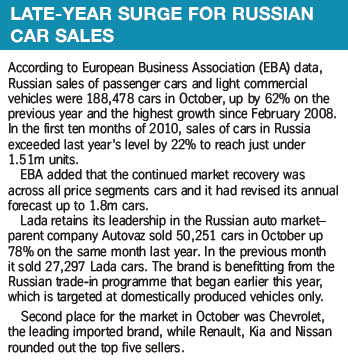 Companies like BLG also need to develop logistics systems within Russia; until now, the focus was mainly on getting cars into the country; final delivery was an afterthought. Initially, BLG will concentrate on setting up networks and storage compounds in the north-west, before gradually extending its operations to the much more thinly populated east. Trucking has become a bit of an issue in Russia. Since the financial crisis hit, many haulage firms have gone out of business and fleets have been sold out of the country, so there could soon be a shortage of capacity.
Companies like BLG also need to develop logistics systems within Russia; until now, the focus was mainly on getting cars into the country; final delivery was an afterthought. Initially, BLG will concentrate on setting up networks and storage compounds in the north-west, before gradually extending its operations to the much more thinly populated east. Trucking has become a bit of an issue in Russia. Since the financial crisis hit, many haulage firms have gone out of business and fleets have been sold out of the country, so there could soon be a shortage of capacity.
Before the crisis, providers also identified numerous routes into Russia as possible alternatives to the Baltic, most of which are now used sparsely. Such entry points include Black Sea ports, such as Illychevsk or Odessa in the Ukraine. BLG also has a hub at the Italian port of Gioia Tauro, from where it can feed volumes to the Black Sea to reach Russia and Ukraine. Yet another way of reaching the Russian market is by rail all the way from Europe, the so-called ‘green’ route. This involves transhipping at Russia or Belarus’s border with Poland because of the different rail track gauge. A very rare solution today, it is an option if and when business picks up again.
Will large-sale imports continue?
Russian Transport Lines (RTL) is a customs clearance and logistics company managing several terminals, including the Fishery Port in St Petersburg, as well as Nova Govan near Ust Luga. RTL’s Elena Zhadanova believes that Russia will be importing large volumes of cars for some time to come, in part because of an underdeveloped and often uncompetitive Russian manufacturing base.
However, some of the issues surrounding imports into Russia haven’t gone away, particularly customs, according to Stephen Fletcher. Customs duty of 30% and VAT of 18% have to be paid, which has traditionally put carmakers off holding stocks there. Space in Finland is nearly unlimited, meanwhile, and cars can be held duty-free indefinitely and when required can be quickly whisked across the border to the end-customer by truck, train or, occasionally, feeder ship.
In recognition of the multiple approaches to the Russian market, Rolf is finalising a joint venture with Wallenius Wilhelmsen Logistics (WWL) to operate the auto and ro-ro terminals in Kotka, Finland, Petrolesport port and Vostochny in the Russian far east.
Kotka is a strong location in which to maintain stocks for the Russian market, Fletcher asserts. It doesn’t have the operational issues of Russian ports and there is plenty of storage space but at the same time it is close enough for more stocks to be moved in a timely manner. Meanwhile, PLP in St Petersburg will provide a niche solution for smaller volumes that need to be moved direct into Russia. “I don’t think it’s a case of one port versus another,” says Stephen Fletcher.
Tran Siberian debate continues
Far-eastern Russian port solutions, such as Vostochny, are an obvious entry point from Asia, although the population and market are very small. But one function they can fulfil is an alternative entry point for cars heading west via the Tran Siberian railway. This is also an effective way of getting volumes into Kazakhstan, adds Fletcher.
NYK, Svein Steimler says, has also looked into the Tran Siberian option. “There are capacity limitations, but if the railway companies can improve the quality of their service, especially reducing current levels of cargo damage, it does offer a potential supply chain solution for some customers.” The flow of cars into Russia is almost entirely one-way. Apart from a few trucks sold in selected Latin American and other developing world markets, there is currently little in the way of wheeled exports–most of Russia’s export earnings are oil, gas or heavy bulk commodities. “This does push logistics costs up somewhat compared with other countries,” in Stephen Fletcher’s opinion.
At the moment, apart from Soviet-era models that are mostly sold locally, most foreign carmakers in Russia assemble cars in relatively low volumes, rather than run full production. However this could change if carmakers, such as Volkswagen in Kaluga, move more towards manufacture as opposed to assembly. This might result in a high-volume factory specialising in a much narrower range of models–many of which would have to be exported to other countries. Other possibilities for export include Russian domestic carmakers, in particular Avtovaz, in whom Renault and Nissan are now heavily invested.
However, most plants remain dedicated to the domestic markets, and the most likely export markets are other central Asian countries, so it is unlikely that much of the volume will be moved by sea.
Ro-ro ports have arguably become less important at the moment, partly because the Russian government has been incentivising local assembly, but investors are betting that over time they will reassert themselves as two-way trade on wheels develops. “I think it will take a couple of years, but it will happen,” says Stephen Fletcher.





